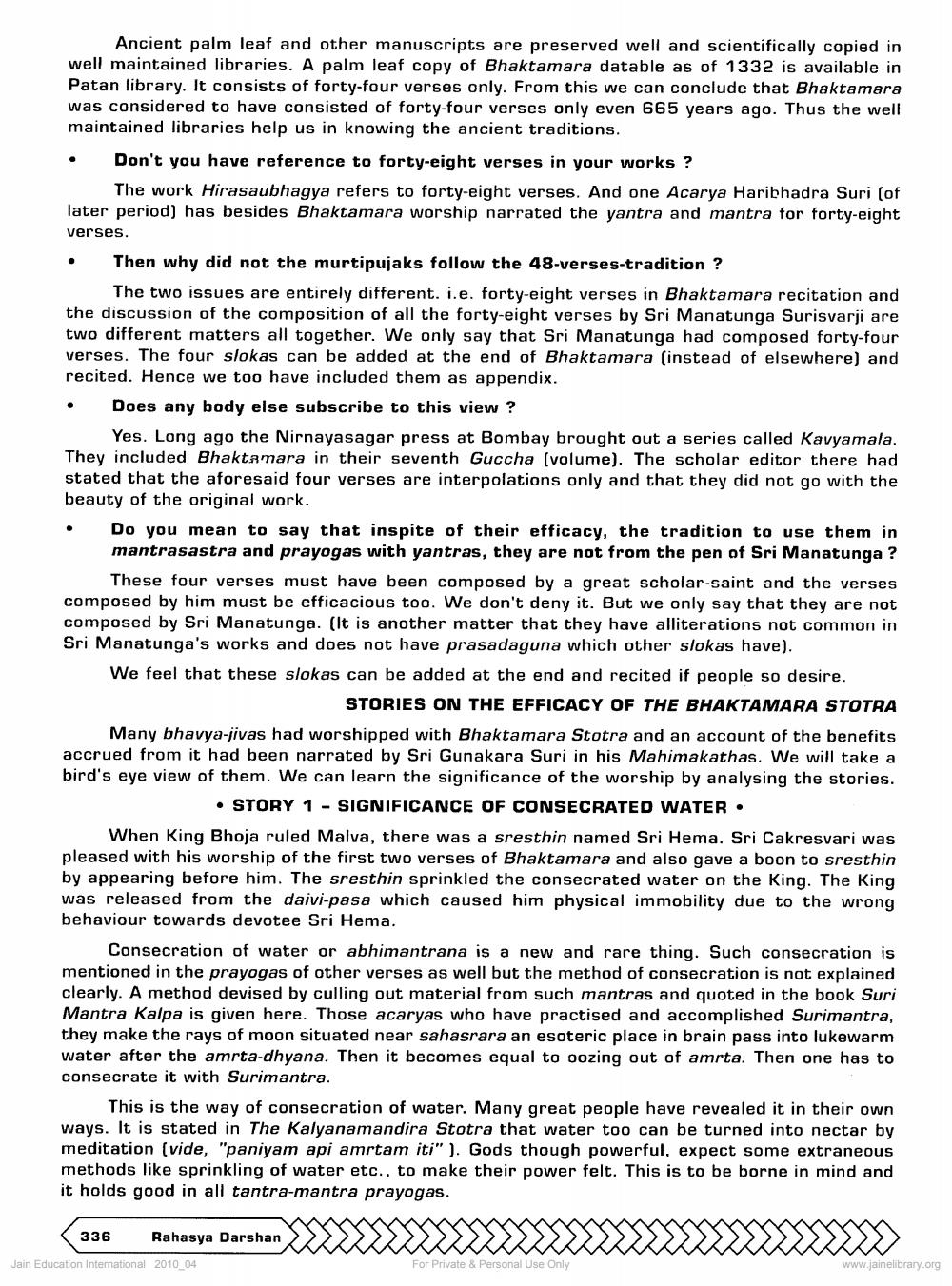________________
Ancient palm leaf and other manuscripts are preserved well and scientifically copied in well maintained libraries. A palm leaf copy of Bhaktamara datable as of 1332 is available in Patan library. It consists of forty-four verses only. From this we can conclude that Bhaktamara was considered to have consisted of forty-four verses only even 665 years ago. Thus the well maintained libraries help us in knowing the ancient traditions. • Don't you have reference to forty-eight verses in your works?
The work Hirasaubhagya refers to forty-eight verses. And one Acarya Haribhadra Suri (of later period) has besides Bhaktamara worship narrated the yantra and mantra for forty-eight verses. • Then why did not the murtipujaks follow the 48-verses-tradition ?
The two issues are entirely different. i.e. forty-eight verses in Bhaktamara recitation and the discussion of the composition of all the forty-eight verses by Sri Manatunga Surisvarji are two different matters all together. We only say that Sri Manatunga had composed forty-four verses. The four slokas can be added at the end of Bhaktamara (instead of elsewhere) and recited. Hence we too have included them as appendix.
Does any body else subscribe to this view ?
Yes. Long ago the Nirnayasagar press at Bombay brought out a series called Kavyamala. They included Bhaktamara in their seventh Guccha (volume). The scholar editor there had stated that the aforesaid four verses are interpolations only and that they did not go with the beauty of the original work.
Do you mean to say that inspite of their efficacy, the tradition to use them in mantrasastra and prayogas with yantras, they are not from the pen of Sri Manatunga ?
These four verses must have been composed by a great scholar-saint and the verses composed by him must be efficacious too. We don't deny it. But we only say that they are not composed by Sri Manatunga. (It is another matter that they have alliterations not common in Sri Manatunga's works and does not have prasadaguna which other slokas have). We feel that these slokas can be added at the end and recited if people so desire.
STORIES ON THE EFFICACY OF THE BHAKTAMARA STOTRA Many bhavya-jivas had worshipped with Bhaktamara Stotra and an account of the benefits accrued from it had been narrated by Sri Gunakara Suri in his Mahimakathas. We will take a bird's eye view of them. We can learn the significance of the worship by analysing the stories.
• STORY 1 - SIGNIFICANCE OF CONSECRATED WATER. When King Bhoja ruled Malva, there was a sresthin named Sri Hema. Sri Cakresvari was pleased with his worship of the first two verses of Bhaktamara and also gave a boon to sresthin by appearing before him. The sresthin sprinkled the consecrated water on the King. The King was released from the daivi-pasa which caused him physical immobility due to the wrong behaviour towards devotee Sri Hema.
Consecration of water or abhimantrana is a new and rare thing. Such consecration is mentioned in the prayogas of other verses as well but the method of consecration is not explained clearly. A method devised by culling out material from such mantras and quoted in the book Suri Mantra Kalpa is given here. Those acaryas who have practised and accomplished Surimantra, they make the rays of moon situated near sahasrara an esoteric place in brain pass into lukewarm water after the amrta-dhyana. Then it becomes equal to oozing out of amrta. Then one has to consecrate it with Surimantra.
This is the way of consecration of water. Many great people have revealed it in their own ways. It is stated in The Kalyanamandira Stotra that water too can be turned into nectar by meditation (vide, "paniyam api amrtam iti" ). Gods though powerful, expect some extraneous methods like sprinkling of water etc., to make their power felt. This is to be borne in mind and it holds good in all tantra-mantra prayogas.
336
Rahasya Darshan
Jain Education International 2010_04
For Private & Personal Use Only
www.jainelibrary.org




